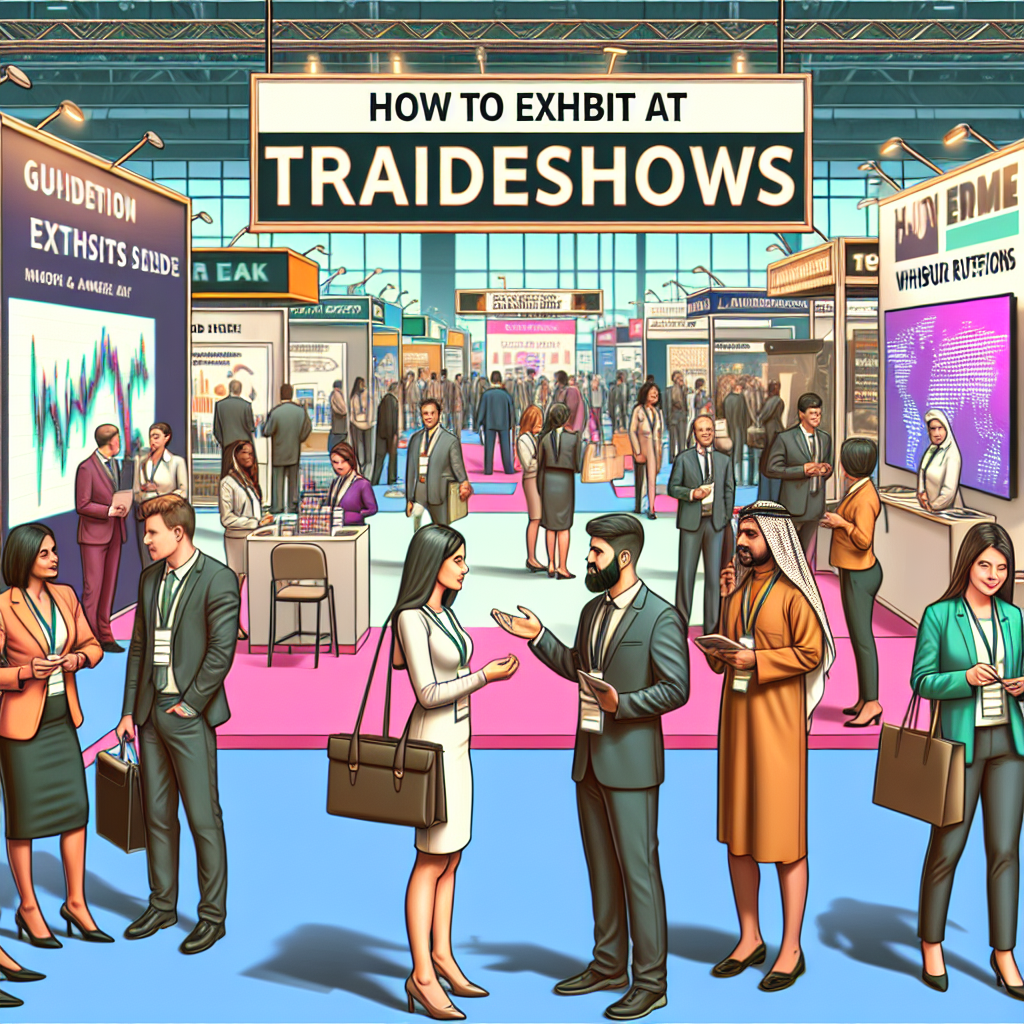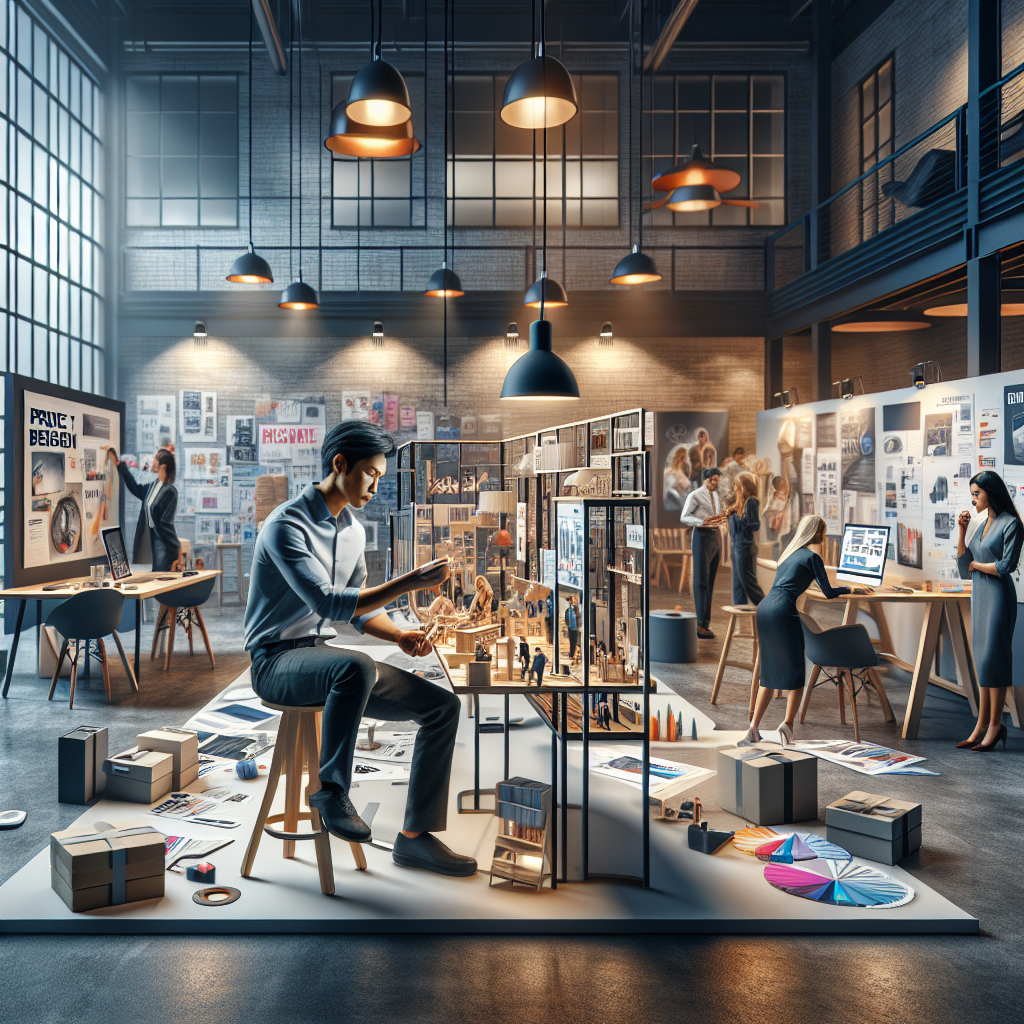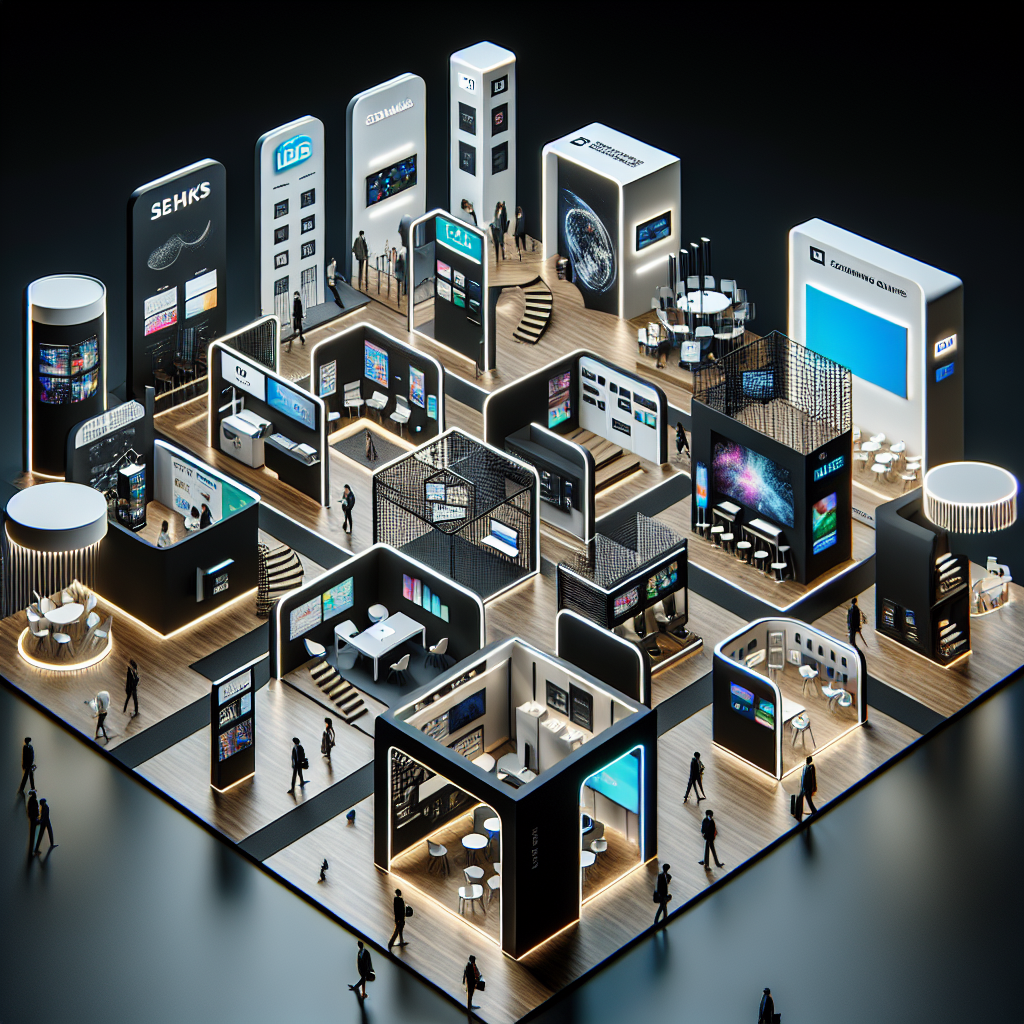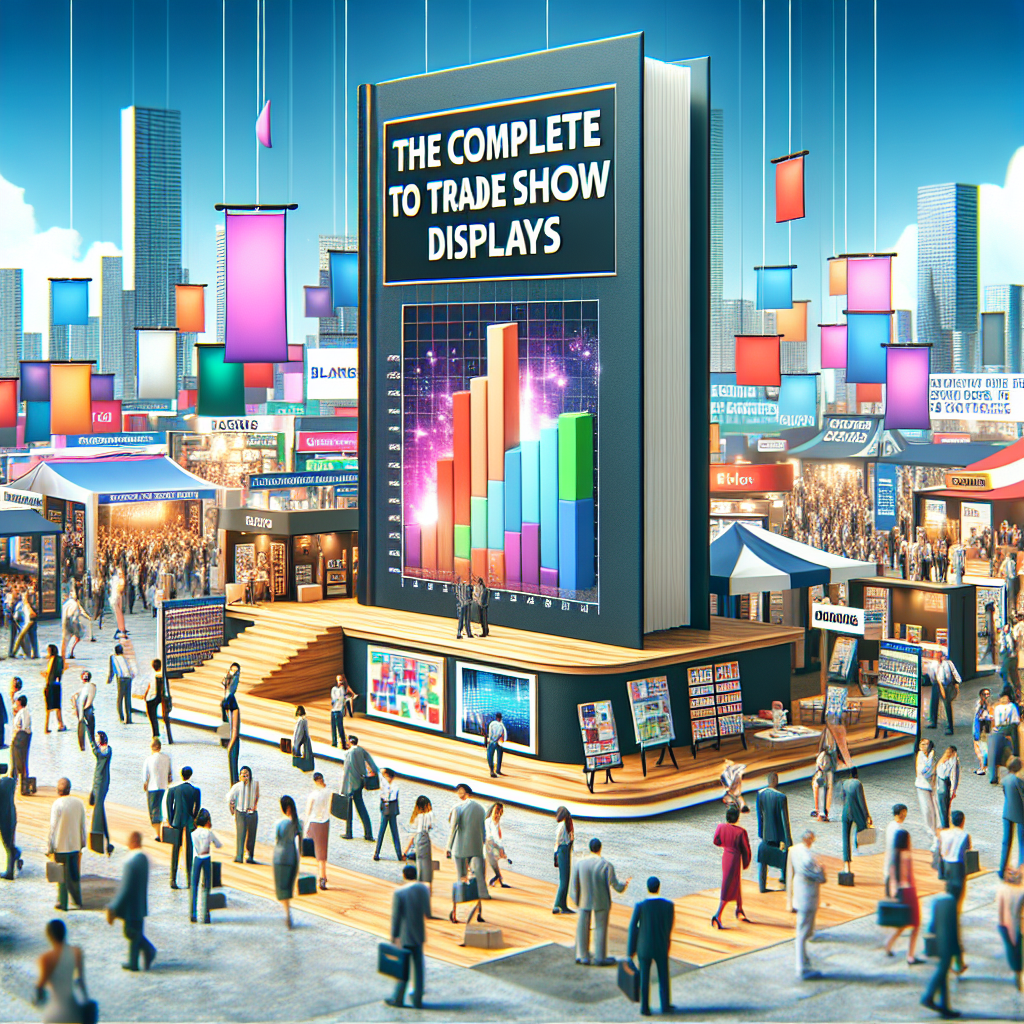The Rise of Immersive Experiences: How Trade Shows are Revolutionizing the Business Landscape
Welcome to the world of trade shows, where innovation, business, and excitement collide in a spectacular display of industry prowess. In this article, we will take you on a journey through the booming trade show industry, offering a sneak peek into the future of this dynamic sector. From the latest technological advancements to the evolving trends in experiential marketing, we will explore how trade shows are transforming businesses and shaping industries.
Trade shows have come a long way since their humble beginnings as simple marketplaces for buyers and sellers. Today, they have evolved into immersive experiences that showcase the cutting-edge products, services, and ideas that are shaping the future. With the rise of globalization and technological advancements, trade shows have become an essential platform for businesses to connect with their target audience, generate leads, and drive sales. In this article, we will delve into the key factors driving the growth of the trade show industry, including the increasing demand for experiential marketing, the role of technology in enhancing the trade show experience, and the rise of niche trade shows catering to specific industries.
Key Takeaway 1: The trade show industry is experiencing significant growth
The trade show industry is booming, with a steady increase in the number of trade shows being organized worldwide. This growth can be attributed to several factors, including advancements in technology, globalization, and the increasing importance of face-to-face interactions in a digital world.
Key Takeaway 2: Trade shows offer unique opportunities for businesses
Trade shows provide businesses with a platform to showcase their products and services, connect with potential customers, and build valuable partnerships. The face-to-face interactions at trade shows allow for direct engagement and networking, leading to increased brand visibility and potential sales opportunities.
Key Takeaway 3: Technology is transforming the trade show experience
The integration of technology has revolutionized the trade show industry. From virtual reality demonstrations and interactive displays to mobile apps and data analytics, technology is enhancing attendee experiences, increasing engagement, and providing valuable insights for exhibitors.
Key Takeaway 4: Sustainability is a growing concern in the trade show industry
With the increasing focus on sustainability, trade show organizers and exhibitors are adopting eco-friendly practices to reduce waste, conserve energy, and minimize their environmental impact. From using recyclable materials to implementing green initiatives, sustainability is becoming a key consideration in the planning and execution of trade shows.
Key Takeaway 5: Collaboration and innovation are driving future growth
The trade show industry thrives on collaboration and innovation. Organizers are partnering with industry experts and technology providers to create unique experiences and stay ahead of the competition. By embracing new technologies, trends, and ideas, the trade show industry is poised for continued growth and success in the future.
The Digital Transformation: Revolutionizing Trade Shows
The trade show industry has undergone a significant transformation in recent years, largely driven by the advent of digital technology. Traditional trade shows were once limited to physical venues, with exhibitors and attendees gathering in person to showcase products, network, and make business deals. However, with the rise of digital platforms, trade shows have expanded beyond physical boundaries, allowing for virtual participation and global reach.
Digital trade shows have revolutionized the industry by providing a cost-effective and scalable alternative to traditional events. Exhibitors can now showcase their products and services to a global audience without the need for expensive booth rentals and logistics. Attendees, on the other hand, can participate in trade shows from the comfort of their homes or offices, saving time and travel expenses.
Moreover, digital trade shows have opened up new opportunities for engagement and interaction. Virtual booths can be customized with multimedia content, allowing exhibitors to showcase their products in a more immersive and interactive way. Attendees can also engage in real-time chats and video conferences, fostering networking and collaboration.
The Rise of Industry-Specific Trade Shows
Another key insight into the booming trade show industry is the rise of industry-specific events. Traditionally, trade shows were often generic, catering to a wide range of industries and sectors. However, as industries become more specialized and niche, there has been a growing demand for trade shows that cater specifically to the needs and interests of particular industries.
Industry-specific trade shows provide a targeted platform for exhibitors and attendees to connect and collaborate within their specific field. These events offer a deeper level of engagement and networking opportunities, as participants share common interests and can delve into industry-specific discussions and trends.
Moreover, industry-specific trade shows enable exhibitors to showcase their products and services to a highly relevant audience. This targeted approach ensures that exhibitors can reach potential customers who are specifically interested in their industry, increasing the chances of generating leads and closing deals.
The Integration of Technology: Enhancing the Trade Show Experience
Technology has not only transformed the format of trade shows but has also enhanced the overall experience for exhibitors and attendees. From advanced analytics to augmented reality, the integration of technology has revolutionized the way trade shows are organized and experienced.
One significant technological advancement in the trade show industry is the use of data analytics. Exhibitors can now collect and analyze data on attendee behavior, preferences, and engagement levels. This data-driven approach allows exhibitors to gain insights into their target audience, enabling them to tailor their marketing strategies and improve their overall trade show performance.
Furthermore, the integration of augmented reality (AR) and virtual reality (VR) has taken the trade show experience to a whole new level. Exhibitors can now create immersive experiences for attendees, allowing them to interact with products and services in a virtual environment. This not only enhances the engagement and interest of attendees but also provides exhibitors with a unique opportunity to showcase their offerings in a memorable and impactful way.
The trade show industry is undergoing a significant transformation, driven by digital technology and changing market demands. The digital transformation has revolutionized trade shows, providing a cost-effective and scalable alternative to traditional events. The rise of industry-specific trade shows has catered to the growing demand for niche events, offering a targeted platform for collaboration and networking. The integration of technology has further enhanced the trade show experience, enabling exhibitors to gather valuable data and create immersive experiences for attendees. As the industry continues to evolve, trade shows are set to become even more dynamic and impactful in the future.
The Rise of Virtual Trade Shows
In recent years, the trade show industry has experienced a significant shift towards virtual events. With advancements in technology and the increasing demand for remote participation, virtual trade shows have emerged as a convenient and cost-effective alternative to traditional in-person exhibitions. This trend is expected to continue growing in the future, transforming the way businesses connect and showcase their products.
One of the main advantages of virtual trade shows is their ability to reach a global audience. Unlike physical events that are limited by geographical constraints, virtual trade shows can be accessed by participants from anywhere in the world. This opens up new opportunities for businesses to expand their reach and connect with potential customers and partners from different regions.
Another key benefit of virtual trade shows is their cost-effectiveness. Traditional trade shows often require significant investments in booth rentals, travel expenses, and marketing materials. In contrast, virtual trade shows eliminate many of these expenses, allowing businesses to allocate their resources more efficiently. This makes it particularly attractive for small and medium-sized enterprises (SMEs) that may have limited budgets for marketing and promotion.
Virtual trade shows also offer a more flexible and convenient experience for both exhibitors and attendees. Participants can access the event from the comfort of their own homes or offices, eliminating the need for travel and accommodation arrangements. Additionally, virtual trade shows provide a range of interactive features such as live chats, webinars, and product demonstrations, enhancing engagement and networking opportunities.
Looking ahead, the future of virtual trade shows seems promising. As technology continues to advance, we can expect even more immersive and interactive virtual experiences. Virtual reality (VR) and augmented reality (AR) technologies, for example, have the potential to revolutionize the way trade shows are conducted. Imagine being able to explore a virtual exhibition hall, interact with virtual product displays, and have real-time conversations with exhibitors, all from the comfort of your own home.
Furthermore, the COVID-19 pandemic has accelerated the adoption of virtual trade shows. With the restrictions on large gatherings and travel, many trade show organizers had to quickly pivot to virtual platforms to ensure business continuity. This forced experimentation has not only demonstrated the viability of virtual trade shows but also highlighted their resilience in the face of unexpected disruptions.
Personalization and Customization
In an increasingly competitive marketplace, businesses are recognizing the importance of personalization and customization in trade show experiences. Attendees are no longer satisfied with generic, one-size-fits-all exhibitions. They expect tailored experiences that cater to their specific needs and interests.
Trade show organizers are responding to this demand by offering personalized experiences through data-driven insights and analytics. By collecting and analyzing attendee data, organizers can gain valuable insights into their preferences, behaviors, and interests. This information can then be used to customize the trade show experience, from personalized recommendations for exhibitors and products to targeted marketing messages.
Moreover, technology plays a crucial role in enabling personalization and customization at trade shows. Mobile apps, for instance, can be used to deliver personalized schedules, exhibitor recommendations, and real-time updates to attendees. Interactive touchscreens and digital signage can also be utilized to provide customized content and interactive experiences at booths.
Looking ahead, personalization and customization are likely to become even more prevalent in the trade show industry. As technology continues to advance, organizers will have access to more sophisticated tools and algorithms for analyzing attendee data. This will enable them to deliver highly personalized experiences that not only meet but exceed attendees’ expectations.
Sustainability and Green Initiatives
In recent years, there has been a growing emphasis on sustainability and green initiatives in the trade show industry. As businesses become more conscious of their environmental impact, they are seeking ways to reduce waste, conserve resources, and promote sustainable practices.
One of the key areas of focus is reducing the carbon footprint of trade shows. Traditional trade shows often generate significant amounts of waste, from promotional materials and booth constructions to food and beverage packaging. To address this issue, organizers are implementing measures such as recycling programs, eco-friendly booth designs, and sustainable catering options.
Another aspect of sustainability in trade shows is the promotion of eco-friendly products and services. Exhibitors are increasingly showcasing their environmentally friendly offerings, from renewable energy solutions to sustainable packaging materials. This not only aligns with the growing consumer demand for sustainable products but also helps businesses differentiate themselves in a crowded marketplace.
Furthermore, technology is playing a crucial role in driving sustainability in the trade show industry. Virtual trade shows, for example, significantly reduce the carbon emissions associated with travel and venue operations. Digital tools and platforms also enable the digitization of marketing materials, reducing the need for printed brochures and flyers.
Looking to the future, sustainability and green initiatives are expected to become even more integral to the trade show industry. As businesses and consumers become more environmentally conscious, there will be increasing pressure on trade show organizers and exhibitors to adopt sustainable practices. This will not only benefit the environment but also contribute to the overall reputation and success of businesses in the industry.
The Rise of Virtual Trade Shows: A Game-Changer or a Missed Opportunity?
The trade show industry has experienced a significant shift in recent years with the rise of virtual trade shows. These online events provide a platform for businesses to showcase their products and services to a global audience without the need for physical attendance. While some argue that virtual trade shows are a game-changer, others believe they are a missed opportunity. Let’s examine both sides of the debate.
Supporters of virtual trade shows argue that they offer numerous advantages over traditional in-person events. Firstly, they eliminate the need for travel, saving both time and money for exhibitors and attendees. This accessibility opens up opportunities for smaller businesses that may not have the resources to participate in physical trade shows. Additionally, virtual trade shows allow for greater flexibility in terms of scheduling, as participants can access the event at their convenience.
On the other hand, critics argue that virtual trade shows lack the personal touch and networking opportunities that physical events provide. The face-to-face interactions at trade shows often lead to meaningful connections and collaborations that are difficult to replicate in a virtual setting. Furthermore, the sensory experience of seeing, touching, and experiencing products firsthand is lost in the digital realm. This can be particularly challenging for industries that rely heavily on product demonstrations and tactile experiences.
It is important to note that virtual trade shows have their limitations. The success of these events heavily relies on the quality of the virtual platform and the ability to recreate the immersive experience of a physical trade show. Additionally, not all industries may be suitable for virtual trade shows. For example, industries that require physical demonstrations or rely on the tactile experience of products may struggle to fully showcase their offerings in a virtual environment.
The Environmental Impact of Trade Shows: Balancing Sustainability and Business Needs
Trade shows are known for their grandeur, with elaborate booth setups, extravagant displays, and excessive use of resources. However, as environmental concerns continue to rise, the trade show industry is facing scrutiny for its impact on the planet. Let’s delve into the controversial topic of balancing sustainability and business needs within the trade show industry.
Advocates for sustainability argue that trade shows must prioritize environmental responsibility. They emphasize the importance of reducing waste, promoting eco-friendly practices, and encouraging exhibitors to adopt sustainable materials and technologies. Some trade show organizers have taken steps towards sustainability by implementing recycling programs, using energy-efficient lighting, and encouraging exhibitors to minimize their carbon footprint.
On the other hand, critics argue that the pursuit of sustainability should not overshadow the primary goal of trade shows: to showcase products and drive business. They contend that implementing strict sustainability measures may limit creativity and hinder exhibitors’ ability to create visually stunning displays that attract visitors. Additionally, they argue that the cost of adopting sustainable practices can be prohibitive for smaller businesses, potentially excluding them from participating in trade shows.
It is crucial to find a balance between sustainability and business needs within the trade show industry. Trade show organizers can encourage exhibitors to adopt sustainable practices without compromising their ability to showcase their products effectively. This can be achieved through education, providing resources and incentives for sustainable initiatives, and promoting collaboration between exhibitors to share sustainable solutions.
The Ethical Dilemma of Exclusive Trade Shows: Inclusion vs. Exclusivity
Trade shows often cater to specific industries or professional communities, creating exclusive environments where like-minded individuals can connect and collaborate. However, this exclusivity raises ethical concerns regarding inclusivity and equal opportunities. Let’s explore the ethical dilemma of exclusive trade shows and the opposing viewpoints surrounding this issue.
Supporters of exclusive trade shows argue that they provide a focused environment for professionals to network and conduct business within their specific industry. These events allow for targeted marketing and ensure that attendees have a shared interest, maximizing the potential for meaningful interactions and collaborations. Exclusive trade shows can also serve as a platform for niche industries or emerging sectors to gain visibility and connect with potential customers.
On the other hand, critics argue that exclusive trade shows can perpetuate inequality and limit opportunities for those outside the chosen industry or professional community. They argue that inclusivity should be a priority, as it promotes diversity, fosters innovation through cross-industry collaborations, and provides equal opportunities for businesses to showcase their offerings. Critics suggest that trade show organizers should strive to create more inclusive events that cater to a broader range of industries and professionals.
Trade show organizers face a challenging ethical dilemma when deciding whether to prioritize exclusivity or inclusivity. Striking a balance between creating targeted, industry-specific events and providing opportunities for cross-industry collaboration is essential. Trade shows can explore options such as hosting separate exclusive and inclusive events, or incorporating inclusive elements within industry-specific trade shows to foster diversity and equal opportunities.
The Evolution of Trade Shows
The trade show industry has come a long way since its inception. In the early days, trade shows were primarily focused on showcasing products and services to potential buyers. However, with the advent of technology and the changing needs of businesses, trade shows have evolved into much more than just a platform for sales. Today, trade shows serve as a hub for networking, knowledge sharing, and industry collaboration.
One of the key factors driving this evolution is the integration of digital technologies into trade shows. With the rise of smartphones, tablets, and social media, trade show organizers have embraced these tools to enhance the overall experience for exhibitors and attendees. For example, many trade shows now have dedicated mobile apps that provide real-time updates, interactive maps, and networking features. This not only makes it easier for attendees to navigate the event but also allows exhibitors to capture leads and engage with potential customers in a more meaningful way.
Another aspect of the evolution of trade shows is the shift towards experiential marketing. Traditionally, trade shows were centered around product displays and demonstrations. While these elements are still important, trade show organizers are now focusing on creating immersive experiences that leave a lasting impression on attendees. For instance, some trade shows incorporate virtual reality or augmented reality technologies to provide interactive and engaging experiences. This not only attracts more attendees but also helps exhibitors stand out from the competition and generate more leads.
Impact of Technology on Trade Shows
Technology has had a profound impact on the trade show industry, revolutionizing the way trade shows are organized and experienced. One of the most significant advancements is the use of data analytics. Trade show organizers now have access to a wealth of data, including attendee demographics, preferences, and behavior. By analyzing this data, organizers can gain valuable insights into the needs and interests of their target audience, allowing them to tailor the event to meet those needs.
Furthermore, technology has also made it easier for exhibitors to track the return on investment (ROI) of their participation in trade shows. With the help of lead capture tools and CRM integration, exhibitors can collect and manage leads more efficiently. They can also track the progress of each lead, from initial contact to conversion, enabling them to measure the success of their trade show participation and make data-driven decisions for future events.
Another area where technology has made a significant impact is in the realm of virtual trade shows. Virtual trade shows allow exhibitors and attendees to connect and interact online, eliminating the need for physical presence. These virtual events offer several advantages, such as cost savings, global reach, and increased accessibility. Virtual trade shows have gained popularity in recent years, especially in industries where physical events may be challenging or impossible to organize, such as during a pandemic.
Key Trends in the Trade Show Industry
The trade show industry is constantly evolving, driven by emerging trends and changing market dynamics. One of the key trends that has gained traction in recent years is sustainability. With increasing awareness of environmental issues, trade show organizers and exhibitors are making efforts to reduce their carbon footprint. This includes using eco-friendly materials, implementing recycling programs, and promoting sustainable practices throughout the event.
Another trend that has been shaping the trade show industry is the integration of artificial intelligence (AI). AI-powered chatbots and virtual assistants are being used to enhance attendee engagement and provide personalized experiences. These intelligent systems can answer frequently asked questions, recommend relevant exhibitors or sessions, and even assist with lead generation. AI has the potential to transform the trade show experience, making it more efficient and personalized.
Furthermore, the ongoing COVID-19 pandemic has accelerated the adoption of virtual and hybrid trade shows. With travel restrictions and social distancing measures in place, many trade show organizers have turned to virtual platforms to continue connecting exhibitors and attendees. Hybrid trade shows, which combine both physical and virtual elements, have also emerged as a popular format, allowing for greater flexibility and accessibility.
Success Stories: Case Studies from the Trade Show Industry
The trade show industry has witnessed numerous success stories where companies have leveraged trade shows to achieve their business goals. One such example is the Consumer Electronics Show (CES). CES is one of the largest trade shows in the world, attracting thousands of exhibitors and attendees from around the globe. Companies like Samsung, LG, and Sony use CES as a platform to unveil their latest innovations and generate buzz among consumers and industry professionals.
Another success story is the Mobile World Congress (MWC). MWC is the premier event for the mobile industry, bringing together leading companies, innovators, and investors. It serves as a platform for showcasing new technologies, networking, and deal-making. Companies like Huawei, Nokia, and Qualcomm use MWC to launch their latest products and forge strategic partnerships.
These success stories highlight the immense value that trade shows can bring to businesses. By participating in trade shows, companies can gain exposure, build brand awareness, and connect with potential customers and partners. Trade shows provide a unique opportunity to showcase products and services in a highly targeted and engaging environment, leading to increased sales and business growth.
The Future of Trade Shows
Looking ahead, the future of trade shows seems promising. As technology continues to advance, trade shows will become even more immersive and interactive. Virtual and hybrid trade shows are likely to become more prevalent, offering a flexible and accessible alternative to traditional physical events. The integration of AI and virtual reality technologies will further enhance the trade show experience, providing personalized recommendations, virtual product demos, and networking opportunities.
Additionally, sustainability will continue to be a key focus in the trade show industry. Organizers and exhibitors will strive to minimize their environmental impact by adopting eco-friendly practices and exploring innovative solutions. This includes leveraging renewable energy sources, reducing waste, and promoting sustainable transportation options for attendees.
Furthermore, the trade show industry will continue to adapt to changing market dynamics and industry trends. As new industries emerge and existing ones evolve, trade shows will play a crucial role in facilitating collaboration, knowledge sharing, and business growth. The trade show industry is poised for further growth and innovation, providing a platform for businesses to showcase their products, connect with industry leaders, and stay ahead of the competition.
The Origins of Trade Shows
The concept of trade shows can be traced back to ancient times when merchants would gather in marketplaces to showcase and sell their goods. These early trade shows were essential for economic development, allowing traders to meet potential customers, exchange ideas, and establish business relationships.
However, it wasn’t until the 19th century that trade shows as we know them today started to emerge. The Industrial Revolution brought about significant advancements in manufacturing and technology, leading to the need for specialized exhibitions to showcase new products and innovations.
The Rise of World’s Fairs
One of the key milestones in the evolution of trade shows was the rise of World’s Fairs in the late 19th and early 20th centuries. These international exhibitions showcased the achievements of nations in various fields, including industry, science, and culture.
World’s Fairs attracted millions of visitors and became an important platform for businesses to promote their products on a global scale. These events featured elaborate pavilions, demonstrations, and interactive displays, setting the stage for the trade show industry to flourish.
The Post-War Boom
After the devastation of World War II, the trade show industry experienced a boom as countries focused on rebuilding their economies. Trade shows became instrumental in stimulating trade, fostering innovation, and encouraging international cooperation.
During this period, trade shows expanded beyond traditional industries and started to encompass a wide range of sectors, including technology, automotive, fashion, and consumer goods. These events provided a platform for companies to launch new products, conduct market research, and network with industry professionals.
The Digital Revolution
The advent of the internet and digital technology in the late 20th century brought significant changes to the trade show industry. Virtual trade shows and online exhibitions emerged, allowing companies to reach a global audience without the need for physical presence.
While virtual trade shows offered convenience and cost savings, they lacked the personal interaction and sensory experience of traditional trade shows. As a result, a hybrid model combining physical and virtual elements became popular, providing the best of both worlds.
The Modern Trade Show Experience
Today, the trade show industry continues to thrive, offering a unique platform for businesses to showcase their products, connect with customers, and stay ahead of industry trends. Trade shows have become more specialized, catering to niche markets and specific industries.
Advancements in technology have transformed the trade show experience, with interactive displays, augmented reality, and virtual reality becoming commonplace. Attendees can now engage with products in a more immersive and interactive manner, enhancing their overall experience.
Furthermore, sustainability and eco-friendliness have become important considerations in the trade show industry. Exhibitors are increasingly adopting environmentally friendly practices, such as using recyclable materials and reducing waste, to align with growing consumer concerns about sustainability.
The Future of Trade Shows
Looking ahead, the trade show industry is poised for further evolution. As technology continues to advance, we can expect more innovative ways to engage attendees and create memorable experiences.
Virtual and hybrid trade shows are likely to become even more prevalent, allowing businesses to reach a global audience and overcome geographical barriers. Additionally, artificial intelligence and data analytics will play a larger role in personalizing the trade show experience and providing valuable insights for exhibitors.
Overall, the trade show industry has come a long way since its humble beginnings. From ancient marketplaces to futuristic virtual exhibitions, trade shows have proven to be a vital catalyst for economic growth, innovation, and global collaboration.
FAQs
1. What is a trade show?
A trade show is an event where companies from a specific industry gather to showcase their products and services to potential buyers, industry professionals, and the general public. It provides an opportunity for businesses to network, generate leads, and promote their brand.
2. Why are trade shows important?
Trade shows are important because they offer a unique platform for businesses to connect with their target audience. They allow companies to demonstrate their products, gain exposure, and build relationships with potential customers and partners. Trade shows also provide valuable industry insights and opportunities for market research.
3. How has the trade show industry evolved in recent years?
The trade show industry has undergone significant changes in recent years. With advancements in technology, trade shows have become more interactive and engaging. Virtual trade shows have also gained popularity, allowing participants to attend events remotely. Additionally, sustainability and eco-friendly practices have become a focus, with many trade shows implementing measures to reduce their environmental impact.
4. What are the benefits of attending a trade show?
Attending a trade show offers several benefits. It allows you to stay updated on industry trends, discover new products and services, and connect with industry experts. Trade shows also provide opportunities for networking, lead generation, and potential collaborations. Furthermore, attending trade shows can help boost brand visibility and credibility.
5. How can businesses make the most of a trade show?
Businesses can make the most of a trade show by planning and preparing in advance. It is essential to set clear goals, design an attractive booth, and train staff to engage with attendees effectively. Offering interactive experiences, providing informative materials, and following up with leads promptly are also crucial for maximizing the benefits of a trade show.
6. Are trade shows only for large corporations?
No, trade shows are not just for large corporations. Trade shows cater to businesses of all sizes, from startups to multinational companies. In fact, trade shows often provide small and medium-sized enterprises (SMEs) with an opportunity to level the playing field and showcase their products and services alongside industry giants.
7. How can trade shows benefit startups?
Trade shows can be highly beneficial for startups. They provide a platform for startups to gain exposure, meet potential investors, and connect with industry influencers. Trade shows also offer valuable market research opportunities, allowing startups to gather feedback and refine their products or services based on customer insights.
8. What are the emerging trends in the trade show industry?
Some emerging trends in the trade show industry include the integration of technology, such as virtual reality and augmented reality, to enhance the attendee experience. Personalization and customization are also gaining importance, with exhibitors tailoring their offerings to meet individual needs. Additionally, sustainability and eco-friendly practices are becoming more prevalent, with trade shows implementing measures to reduce waste and promote environmental responsibility.
9. How can businesses measure the success of their trade show participation?
Businesses can measure the success of their trade show participation by setting specific goals and tracking relevant metrics. These metrics may include the number of leads generated, sales closed, brand impressions, social media engagement, and post-event follow-ups. Conducting surveys or seeking feedback from attendees can also provide valuable insights into the effectiveness of trade show participation.
10. Are virtual trade shows here to stay?
Virtual trade shows have gained popularity, especially during the COVID-19 pandemic when in-person events were limited. While virtual trade shows offer convenience and cost savings, in-person trade shows still hold significant value in terms of networking and building personal connections. It is likely that a hybrid model, combining both virtual and in-person elements, will become more prevalent in the future.
1. Stay informed about industry trends
One of the key takeaways from ‘Unveiling the Future: A Sneak Peek into the Booming Trade Show Industry’ is the importance of staying up-to-date with industry trends. This applies not only to the trade show industry but also to your own field of interest or profession. By staying informed, you can anticipate changes, adapt quickly, and stay ahead of the competition.
2. Network strategically
Networking is crucial in the trade show industry, but it can also be valuable in your daily life. Whether you’re attending a conference, a social event, or even just meeting new people, make an effort to network strategically. Identify individuals who share your interests or can offer valuable insights, and build meaningful connections that can benefit you both personally and professionally.
3. Embrace technology
The trade show industry is constantly evolving, thanks to advancements in technology. Similarly, embracing technology in your daily life can enhance productivity, efficiency, and convenience. Explore new apps, software, or devices that can streamline your tasks, improve communication, and help you stay organized.
4. Cultivate a growth mindset
In the trade show industry, adaptability and a growth mindset are essential for success. Apply this mindset to your own life by embracing challenges, seeking opportunities for personal and professional growth, and being open to learning from failures. Cultivating a growth mindset will enable you to overcome obstacles and continuously improve.
5. Prioritize self-care
Trade show professionals often work long hours and face high levels of stress. It’s crucial to prioritize self-care to maintain physical and mental well-being. In your daily life, make time for activities that rejuvenate you, such as exercise, meditation, spending time with loved ones, or pursuing hobbies. Taking care of yourself will improve your overall productivity and happiness.
6. Develop effective communication skills
Effective communication is key in the trade show industry, whether it’s with clients, colleagues, or attendees. In your daily life, honing your communication skills can enhance your relationships, both personal and professional. Practice active listening, express yourself clearly and assertively, and be mindful of non-verbal cues. Strong communication skills will help you navigate various situations with ease.
7. Embrace diversity and inclusion
Diversity and inclusion are crucial in the trade show industry, as they foster creativity, innovation, and a broader perspective. In your daily life, embrace diversity and inclusion by seeking out diverse experiences, engaging with people from different backgrounds, and challenging your own biases. Embracing diversity will enrich your life and broaden your horizons.
8. Set goals and track progress
In the trade show industry, setting goals and tracking progress is essential for measuring success. Apply this practice to your daily life by setting both short-term and long-term goals. Break them down into actionable steps, and regularly evaluate your progress. Setting goals will provide direction and motivation, helping you achieve personal and professional growth.
9. Emphasize creativity and innovation
In the trade show industry, creativity and innovation are valued for creating memorable experiences. In your daily life, encourage creativity and innovation by seeking out new perspectives, exploring different hobbies or interests, and challenging yourself to think outside the box. Emphasizing creativity will enhance problem-solving skills and spark new ideas.
10. Embrace continuous learning
The trade show industry is constantly evolving, and professionals must stay updated with the latest trends and technologies. Similarly, in your daily life, embrace continuous learning by seeking out new knowledge, attending workshops or seminars, reading books, or taking online courses. Embracing lifelong learning will keep your mind sharp and open doors to new opportunities.
Conclusion
The trade show industry is experiencing a significant boom, driven by advancements in technology and the increasing demand for immersive experiences. This article has provided a sneak peek into the future of trade shows, highlighting key trends and insights that are shaping the industry.
Firstly, the integration of virtual and augmented reality technologies is revolutionizing the trade show experience. These technologies offer attendees the opportunity to explore products and services in a more interactive and engaging way, transcending the limitations of physical space. Additionally, the rise of data analytics and artificial intelligence is enabling exhibitors to gather valuable insights about their target audience, improving their marketing strategies and enhancing the overall event experience. Moreover, sustainability has become a key focus in the trade show industry, with organizers and exhibitors implementing eco-friendly practices to reduce waste and minimize the environmental impact of these events. Lastly, the increasing globalization of trade shows is providing businesses with a platform to expand their reach and tap into new markets.









